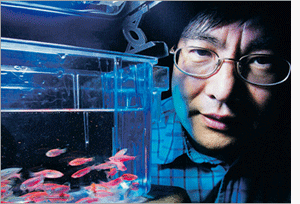The Straits Times - 17 March 2007
Geneticist's glowing fish work featured in best-selling thriller book
DID you know popular writer Michael Crichton’s futuristic thriller Next has a segment on the fishy work of a real-life National University of Singapore scientist?
The soft-spoken academic is Associate Professor Gong Zhiyuan – mentioned on page 165 of the bestseller, as the creator of glowing fish with fluorescent jellyfish genes.
 GLOWING WORK: Prof Gong’s work on GloFish, genetically modified fish with fluorescent genes which can act as monitors for pollution, has left him so busy he has had no time to read much of the book he was featured in. He is now working on transferring the fish’s DNA to a chip. - Photo by Lau Kook Kong GLOWING WORK: Prof Gong’s work on GloFish, genetically modified fish with fluorescent genes which can act as monitors for pollution, has left him so busy he has had no time to read much of the book he was featured in. He is now working on transferring the fish’s DNA to a chip. - Photo by Lau Kook Kong
“I was really quite surprised,” Prof Gong said of his reaction on finding out about his “literary fame”.
Popularly known as GloFish, the red luminescent zebra fish hit American pet shelves in 2003 as the first transgenic pet, to wild success.
More than 100,000 fish were sold in the first month alone, at almost US$18.60 (S$28.40) a piece.
They are also sold in Malaysia, Taiwan and Hong Kong, but are banned here due to strict laws governing genetically modified animals.
In fact, the neon specimens serve a higher purpose than just as pretty pets.
Unlike their predecessors, subsequent generations of the fish were bred to glow in the presence of only certain chemicals.
The fish act as “canaries” – monitoring water pollution levels. The presence of contaminants like oestrogen make the modified zebra fish glow: The more pollution, the brighter they will be.
Most chemical tests show only the presence of pollutants. But the fish biomonitors allow immediate identification of the culprit contaminant, explained Prof Gong.
The 4cm-long fish can be engineered to detect different types of substance – from hormones to chemical waste, he added.
After 11 years on a project as successful as this, Prof Gong is as keen as ever on his research.
He is heartened by the attention given to research by the Government, and the greater focus on the environment and water technologies. “There is no better time to pursue this field,” he said.Further studies include transferring zebra fish DNA onto a chip, which can be used to test for toxicity and pollution levels.
All this has left Prof Gong too busy with work, with not enough time to flip through the book which features him.
He has read only the first two chapters. “But I’ll definitely make time to finish it,” he said.
TANIA TAN
Copyright @ 2007 Singapore Press Holdings. All rights reserved.
|